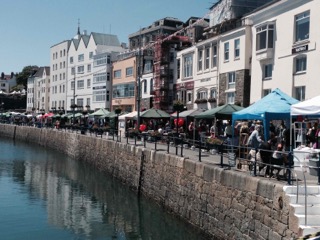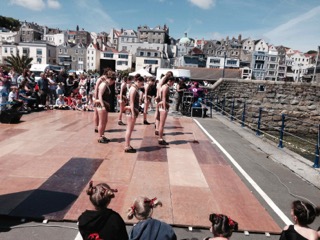N 49 27.359 W 002 31.922

Date: Sunday
7th June 2015 Position: St
Peter Port, Guernsey
At long last I am away from Poole after a series of delays. Last minute technical difficulties and the
weather meant I had stayed longer than I wanted to. The two leisure batteries died on me and had
to be replaced and then there was a problem with the wind generator. It had already been back to the manufacturer once
to have the bearings replaced which was my fault for not removing it when the
mast was down over winter. Once it had
been reinstalled it worked for a while and then just stopped putting power into
the system. It turned out to be the
circuit board in the rear of the unit so I ordered a new one and replaced
it. Half a dozen times climbing up and
down the mizzen mast keeps you fit.
So I left Poole Boat Haven on Thursday and put my anchor down in
Studland Bay, just outside Poole harbour, to do a few last minute jobs and to
wait for a suitable tide to sail across the Channel. I set off on Friday at 14.00 hrs. to make for
St Peter Port but the wind had other ideas.
The forecast had been reasonable but shortly after I had left and was
under sail there was a strong wind warning over the VHF from the coastguard. The wind was from the SSW and it steadily
grew stronger overnight up to 22 knots at one point. Celtic Dawn was sailing
beautifully even though we were beating into the wind and Henry, the Aries
windvane, kept us on track nicely.
However, about four hours before I reached my waypoint for the Alderney
race I knew I would have a problem. The
wind had been from the SSW all night and showed no sign of changing. This was
the exact course I needed to be on to make for St Peter Port once I entered the
race and this would put me directly into the wind. For anyone who does not know, the tides around
Alderney run very strong and the area has a fearsome reputation in bad weather
that is well deserved. I have been
through the Alderney race many times before, even at night, but always in
reasonable conditions. I weighed up the
situation. It was night the wind had been
blowing hard all day so I didn’t know what the conditions would be like in the
race. Add into this situation the fact
that my chart plotter was playing up and I would be entering an area where there
were many dangers to navigate. So I
decided that discretion was the better part of valour and changed course for
Braye Harbour in Alderney. It may seem along way out to make such a decision
but as I said the tides around Alderney need respect and having made the
decided to make for Braye I didn’t want to be swept into the race by the tide,
which can easily happen if you don’t plan early enough.
After passing the shipping lanes, which were remarkably quite for once,
I arrived in Braye at 01.30 hrs. and put my anchor down in the bay.
Sometimes life gives you little unexpected bonuses. A few days earlier I had made roast chicken
for dinner. With the leftovers I made a
lovely chicken stew the next day and was about to throw away the remaining bit
but being to lazy to wash the pan up I put it in the fridge and forgot about
it. A nice bit of tasty chicken stew and
a couple of slices of butter bread were a welcome bonus after twelve hours of
beating into wind. The next morning the
wind was still fresh and from the SSW but I wanted to make St Peter Port that
day. Departure time for going south from
Braye is four hours after high water at St Helier. This gives you a counter current against the
inshore until clear of Branchetais Ledge after which the south going stream
will be away. That gave me the morning
to check the boat over and I noticed that the wind generator and solar panels
were not producing any amps. This really
annoyed me as the day before they had performed exceptionally well. Between them they had produced 69 amps over
36 hours. But there was nothing I could
do about it for the time being. I left
Braye at 14.00 hrs. and after a lively crossing under engine I arrived at St
Peter port at 19.00 hrs. I went into the
harbour but it was absolutely packed with boats rafted up so I anchored in the
bay next door and had a pleasant night with a few other yachts with the same
idea. The next morning I decided to go
into the harbour. Being solo you have to
make sure that in tight situations you are prepared so I put out fenders and set
up line on the port and starboard sides ready to moor up either way and weighed
anchor.
I like Guernsey and St Peter Port is a nice harbour to be holed up in
for a few days. The main road runs right
past the harbour front and you feel like you are part of the town unlike in St
Helier where it feels like you are in a big concrete box. During the summer months on a Sunday they
close of the man road to traffic and have a kind of festival of music, dance
and literature. There were lots of
stalls selling various local products and the whole scene was really
colourful. It was also great to see the
children getting involved in the various events.
Now I am here I need time to get the last few problems solved. I have an engineer coming today to look at
the chart plotter. Hopefully it will not
be a serious problem but lets see. The
other pressing problem is the autopilot that has not been working since I put
the boat back in the water. When I
started the fit out for this project I had two choices regarding steering. The first was to replace the old autopilot
with a new one and the second was to fit a windvane, which is a mechanical
system that works off the wind and does not use any electrical power. I chose the second option on the basis that a
windvane would save on battery power while sailing and the fact that I had a
working autopilot, albeit old, at the time.
So after researching the various options I selected a servo-pendulum
system and brought an Aries Windvane from a chap in Denmark, Peter Matheson,
who took over the making of them from the original designer. The principle is very simple. You have a vane that sticks up from the top
of the unit that you orientate to the course you require by setting it at 90
degrees to the wind. As the boat goes off
course the wind moves the vane to one side and through a series of gears turns
the rudder at the bottom of the unit.
The rudder swings to one side and in turn this movement pulls lines that
are attached to the helm and steers the boat.
Very simple and very effective! Henry,
as I call him/it, has done remarkably well.
He steered a good course across the Channel and seems to work better
when the wind increases. When I motored
from Braye to St Peter Port he still did the steering but the wind was quite
strong then. The problem is that in
light conditions he will not be effective and that will mean steering by hand
unless I can get the problem resolved. I
shall let you know how I get on.
Bye for now. Signing off Ted.
|



